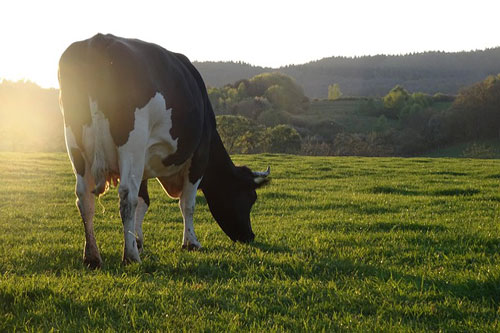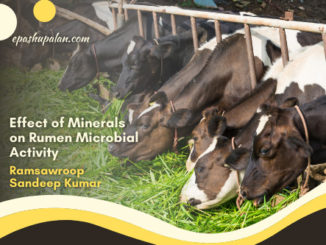Introduction
Livestock provides 4.11% of the national GDP, and agriculture accounts for about 19.9% of the GDP (GOI 2021-22) in India. According to predictions, crop residue would offer 54% of all fodder, whilst rangelands will give 18% and cultivated fodder crops will only provide 28% (Hegde, 2010). A key issue such as inadequate nutrition results from the progressive growth of the livestock populations and the accompanying rise in feeding requirements. In tropical and subtropical areas, as majority of the plants in which animal graze is rich in oxalate content. Generally oxalate toxicity occurs when the dairy animals which are not adapted to oxalate are allowed to graze in the fields which contains the grasses with high oxalate content and also when more amount of oxalates are ingested by the animals then their normal rumen degrading capacity they are absorbed in the blood stream from rumen as calcium and magnesium salts, which later gets deposited in the kidney and lead them to failure. In this way both acute and chronic oxalate poisoning/toxicity may have a great effect in the economy of the dairy industry.
Oxalate Containing Plants and Different Factors
There are many plants reported to contain threatening levels of oxalates, also there are various factors responsible for the oxalate content of the plants.
Various tropical grasses contain soluble oxalates in sufficient concentration to induce calcium deficiency in grazing animals.
- These include buffel grass (Cenchrus ciliaris), pangola grass (Digitaria decumbens), setaria (Setaria sphacelata), bathu (Chenopodium album) and kikuyugrass (Pennisetum clandestinum) and halogeton. Guinea grass (Panicum maximum), bajra (Pennisetum glaucum) and Napier Bajra Hybrid (Pennisetum glaucum x Pennisetum purpureum) contain oxalate content with in the safe limit, however, they may prove toxic if fed over for extended period of time.
- In India rice straw is fed as a basal diet to ruminants. Rice leaves contained 3.0-6.0% oxalate depending on growth stage and culture conditions (Ji and Peng, 2005).
- The leaves of fodder beet contained up to 10% soluble oxalate. The crop residues were found to contain oxalate content varied from 1.1- 1.7%. Leaves normally contain higher oxalate content than stem so cultivars with high proportion of leaves.
- Seasonal variation strongly affects the level of oxalate level in Napier Bajra Hybrid. Among different harvest seasons (summer, monsoon, autumn, pre-winter), soluble oxalate content was highest in the summer (2.08%) i.e. the month of June and decreased afterwards in the subsequent harvest seasons in Napier Bajra Hybrid. Higher values of oxalate during the month of June and July might be due to the peak in growth during summer and rainy seasons.
- Clipping interval strongly influence oxalate content in different plants. In setaria more oxalate was present in young plant than in mature plant. Napier grass, Napier Bajra Hybrid and pearl millet crops, oxalate content declined as the harvest interval increased.
- Oxalate concentrations in Napier grass declined with the age of the plant material. It may be due to more oxalate synthesis rate at early stages of plant growth in these species.
- Ruminants (e.g. goats) tend to be more tolerant of oxalate than non-ruminants (e.g. horses). Rumen bacteria degrade oxalate into formic acid and carbon dioxide rendering it non-toxic.
- Prolonged grazing by cattle and sheep on some tropical grasses can result in severe hypocalcaemia.

Oxalate Metabolism
There are four routes by which oxalate are metabolized in ruminants when they consume oxalate rich feeds.
- The soluble oxalate may be degraded by rumen micro flora.
- The soluble oxalate may combine with calcium in the feed to become insoluble calcium oxalate and then excreted in the feces.
- The soluble calcium may be absorbed in through the rumen to the blood stream where they combine with blood calcium to form insoluble crystals. These crystals get precipitated in the kidney during circulation making kidney prone to failure.
- The insoluble oxalate may pass through digestive tract without causing any harmful effects to body. Oxalates play important role in the calcium regulation, Ion balance, plant protection, tissue support and heavy metal detoxification.
Clinical Signs
The animal may show clinical signs within few hours of ingestion. The various clinical signs may include: muscle tremors, staggering gait, tetany, weakness, diarrhea, recumbency resulting from hypocalcemia and hypomagnesemia. Coma and death may result within 12 hours. If animals survive the acute stage of oxalate poisoning they succumb to kidney failure. As a result the animals become uremic (increased serum creatinine and urea nitrogen levels) and they become anorectic and finally lead to death due to coma.
Horses occurs disturbance in calcium to phosphorus ratio as the calcium combines with the oxalate to form insoluble calcium oxalate. As there is reduction in the serum calcium level the parathyroid hormone gets released which mobilizes the calcium from the bones. As this process continues for some time the bone becomes softer as there is drainage of calcium from the bone matrix. This leads to the condition called nutritional secondary hyperparathyroidism. Compensatory fiber proliferation takes place and the bone gets misshapen. This condition is common in the facial bones of horses giving them the name “big head disease”. Ruminants are also affected like horses but they are less prone as their rumen microbes can utilize the oxalate.
Diagnosis
Diagnosis can be done by on the basis of clinical signs (hypocalcemia and oxalate crystals in the urine).
Treatment
Calcium borogluconate should be given intravenously or subcutaneously as 25% solution around 300-500 ml for dairy animals. We can also administer calcium gluconate, magnesium sulphate, glucose and electrolyte solution so that the orally calcium hydroxide (lime water) can also be provided to dairy animals.
Preventive Measures
- Always maintain the calcium to oxalate ratio higher than 0.5:1 in the diet of dairy animals.
- Animals should not be grazed in the oxalate rich plants predominating grasslands.
- The oxalate rich grasses can be fed along with legumes as they contain high amount of calcium.
- It is reported that alfalfa has the ratio of calcium to oxalate 1.5:1 which is very safe to the animals.
- Animals should be given at least a week for adaptation so that sufficient microflora gets established in their rumen to utilize the oxalate rich plants.
- Overstocking and overgrazing may potentiate the oxalate poisoning so it must be avoided.
- When the animals are in high risk of oxalate poisoning supplementary calcium sources such as dicalcium phosphate should be fed.
Conclusion
Oxalates found in various leguminous and non-leguminous fodder crops that interfere with feed utilization either directly or indirectly through their metabolic byproducts, negatively impact dairy animal health and production, reducing nutrient intake, digestion, absorption, and utilization. Various negative effects such as reduced intake, bioavailability of nutrients, poor growth, infertility, and reproduction-related issues emerge in animals due to the consumption of oxalate rich forages. Chopping, drying under sun, ensiling, haylage and some agronomic practices such as harvesting management, irrigation and fertilizer management practices, and mixing of leguminous with non-leguminous fodder crops could help in improving fodder qualities and alleviating the negative impact of oxalate on dairy animal health and performance.
References
- Dhillon, K. S., B. S. Paul, R. S. Bajwa, and J. Singh. 1971: A preliminary report on a peculiar type of napiergrass (Pennisetum purpureum, ‘Pusa giant’) poisoning in buffalo calves. Indian J Anim Sci., 41 : 1034-1036.
- Gorb, T. W. and W. J. Maksakow. 1962: Influence of oxalate rich feed on mineral metabolism and some physiological values in ruminants. Arch Tierernahrung., 12 : 27-35.
- Hegde, N. G. (2010). Forage resource development in India. Souvenir of IGFRI foundation day.
- Kaur, G., S. Mandhania, D. P. Chaudhary. 2012: Calcium oxalate in Napier Bajra Hybrid: Trends. Indian J Anim Nutr., 29 : 58-62.
- Kaur, R., Goyal, M. and Tiwana, U. S. (2016). Influence of seasonal variation on oxalate accumulation in Napier Bajra hybrid under different nitrogen nutrition. Range Management and Agroforestry, 37 (1), 62-68.
| The content of the articles are accurate and true to the best of the author’s knowledge. It is not meant to substitute for diagnosis, prognosis, treatment, prescription, or formal and individualized advice from a veterinary medical professional. Animals exhibiting signs and symptoms of distress should be seen by a veterinarian immediately. |






Be the first to comment